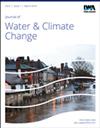树木枯死和随之而来的水质变化加速了中欧森林湖泊与气候相关的变暖进程
IF 3.1
4区 环境科学与生态学
Q2 WATER RESOURCES
引用次数: 0
摘要
由于气候变化,许多湖泊的水温最近都有所上升。我们评估了两个波希米亚森林湖泊(捷克共和国)从 1998 年到 2022 年的云量、太阳辐射、风、气温和水温、冰盖、温跃层深度、透明度和成分的变化趋势。湖泊水温每十年上升 0.32-0.47 °C,冰盖期每十年减少 11.7-14.8 天。这些变化主要与大部分月份气温升高以及太阳辐射增加(由于云量减少)有关,尤其是在 3 月和 11 月(冰期开始/结束前的月份)。冬季积雪量减少(3.8 厘米/10 年-1)进一步加速了冰的提前融化。两湖水温≥4 ° C 的天数同样增加了 12-13 天(十年-1)。然而,在集水区树木枯死的湖泊中,水温≥20 °C的天数增加了,夏季温跃层深度也减少了。树木的枯死加速了有机碳和磷的沥滤,增加了水的褐化和藻类的生成,降低了水的透明度。太阳辐射被较浅的水层吸收。因此,集水区森林的变化导致了湖水温度对气候变化反应的变化。本文章由计算机程序翻译,如有差异,请以英文原文为准。
Tree dieback and subsequent changes in water quality accelerated the climate-related warming of a central European forest lake
The water temperature of many lakes has recently risen as a result of climate change. We evaluated trends in the cloudiness, solar radiation, wind, air and water temperatures, ice cover, thermocline depth, transparency, and composition of two Bohemian Forest lakes (Czech Republic) from 1998 to 2022. Lake water temperatures increased by 0.32–0.47 °C decade−1, and the ice cover periods decreased by 11.7–14.8 days decade−1. These changes were mostly associated with increasing air temperatures during most months and increasing solar radiation (due to decreasing cloudiness) especially in March and November (the months preceding ice-on/off). Decreasing snow cover in winter (by 3.8 cm decade−1) further accelerated the earlier ice melt. The number of days with water temperature ≥4 °C increased similarly in both lakes by 12–13 days decade−1. However, the number of days with water temperature ≥20 °C increased and the depth of the summer thermocline decreased more in the lake with tree dieback in its catchment. Tree dieback accelerated the leaching of organic carbon and phosphorus, increasing water brownification, algal production, and decreasing water transparency. Solar radiation was absorbed in shallower water layers. Changes in catchment forest thus contributed to the variability in the response of lake water temperatures to climate change.
求助全文
通过发布文献求助,成功后即可免费获取论文全文。
去求助
来源期刊

Journal of Water and Climate Change
WATER RESOURCES-
CiteScore
4.80
自引率
10.70%
发文量
168
审稿时长
>12 weeks
期刊介绍:
Journal of Water and Climate Change publishes refereed research and practitioner papers on all aspects of water science, technology, management and innovation in response to climate change, with emphasis on reduction of energy usage.
 求助内容:
求助内容: 应助结果提醒方式:
应助结果提醒方式:


